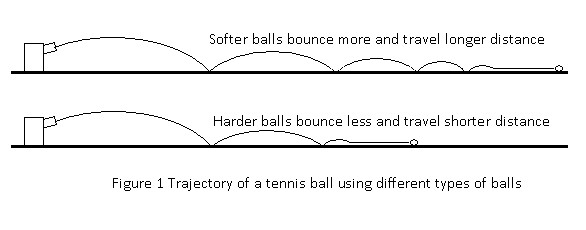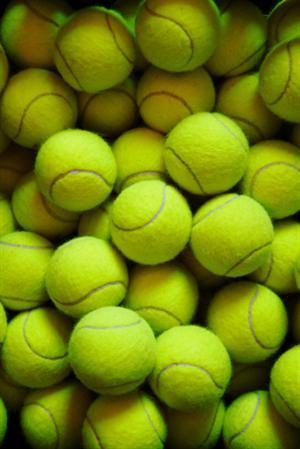| Complexity level: | 5 |
| Project cost ($): | 30 |
| Time required: | 1 hour to prepare, 1 day for experiment |
| Material availability: | Tennis balls may be purchased from a sports shop |
| Safety concerns: | Be careful not to stand in the path of trajectory of the balls when they are launched. |
Hypothesis
Softer balls will be bouncier and thus, be able to travel longer distances as compared to harder balls.
Overview
Why do balls bounce?
When a ball hits the ground, the air inside the ball is compressed. Energy is stored in the compressed air and when the ball bounces upward, the compressed energy is released and the original condition of the air in the ball is restored.
A traveling ball will have both kinetic energy and potential energy. When a ball is lifted above the ground, it gains potential energy. When the ball is dropped and it begins to move downwards, the potential energy is converted to kinetic energy. As the ball touches the ground, the energy is temporarily stored in the compressed air inside the ball. As the ball rises upwards again the compressed energy is released and the ball gains kinetic energy. As the ball rises higher, the kinetic energy decreases and potential energy increases, causing it to fall down again.
As the ball continues to bounce, the height will reduce. This is because some of the energy that was stored in the ball is lost through friction between the air and the felt/rubber (surface) of the ball. This energy is lost and dissipated in the form of heat.
Scientific Terms
Materials
The materials required for this experiment:
- 3 different brands of tennis balls, each with a different degree of hardness. Check with the store salesperson, if you are not sure which of these balls are harder/softer. You will need 5 tennis balls from each brand
- A tennis ball launcher
- Measuring tape ?100 meters
- A 1 meter long ruler
- Large open field
- Assistant to help with measurements
- Permanent marker pen
Procedure
- For this experiment, the independent variable is the brand of tennis ball. The dependent variable is the distance traveled by the ball. This is determined by using a measuring tape to measure the distance traveled. The constants (control variables) are the settings and position of the tennis ball launcher, the conditions of the field and the temperature/wind conditions.
- The balls are first numbered and marked using a permanent marker pen.
- The bounciness of the tennis balls is first determined. They are dropped from a height of 1 meter on to a flat surface and the number of times it bounces is counted with the help of the assistant. The results are recorded in the table 1 below.
- The experiment is now moved over to the field. Using a tennis ball launcher, the balls are launched from the same launcher and in the same direction and the distance traveled by each ball is measured and recorded. With the help of a measuring, the distance is measured and recorded in table 2 below.
Results
Table 1 Number of times the ball bounces off the ground

Brand A ball is the softest as it has the highest number of bounces. Brand B ball has medium hardness and brand C ball is the hardest because it has the lowest number of bounces.
Table 2 Distance traveled by the tennis ball from the launcher.

The results show that the soft bouncier balls are able to travel further compared to the hard and less bouncy balls.
Conclusion
The hypothesis that the softer ball will be bouncier and be able to travel longer distance compared to harder balls is proven to be true.

The manufacturers of sports gear use different methodologies when producing their balls. Each manufacturer has his own know how or secret formula, which is based on knowledge, research or experience. That is why although different balls look the same from the exterior, balls from different manufacturers will perform differently under different conditions. This gives sports enthusiasts the opportunity to choose the ball that best enhances their performance.
Also consider
The experiment can also be done on a concrete floor instead of in a field.
Try to repeat the experiment under different temperature conditions.
References
- Bouncing balls (energy) demo - http://www.physics.ucsb.edu/~circus/energydemo.htm
- Bouncing balls home page - http://www.howeverythingworks.org/bouncing_balls.htm

